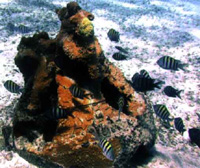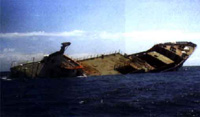
Since the early 1990s, Project AWARE has helped turn
several ships into artificial reefs off the Canadian, Mexican,
US, UK and most recently Kenyan coasts. Organisers thoroughly
clean the ships and open many passageways to make them
appealing habitats to marine life as well as safer for
visiting divers. Project AWARE has also continuously provided
support to reefball projects worldwide. These initiatives help
take pressure off the natural reefs which are in decline. The
theory is simple: the more people who use the artificial
reefs, the fewer use natural ones. Natural reefs therefore
have time to recover and replenish. However, it is not that
simple and some issues should be mentioned concerning some
unique aspects of artificial reefs and dive tourism. Several
critical issues of national importance provide the focus for
many debates regarding manmade reef activities. These include
permit programmes, regulatory requirements, materials
criteria, liability, research and evaluation, site location,
and the role of all parties involved in artificial reef
development, management and regulation.
Regulatory requirements
It is
laudable that dive tourism entities are interested in learning
how to properly prepare and place artificial reefs. In
developed countries today, the lion's share of the expense in
preparing a ship for placement is in cleaning it to the high
standards required by environmental regulators. In some
countries such rigorous requirements don't apply but it is
important that dive operators who want to create an artificial
reef adhere to these requirements even when not required by
local law. |
A poorly prepared ship can have a devastating impact on
marine life. Derelict ships, in particular, contain
considerable amounts of toxic substances such as PCBs,
asbestos, lubricants / fuel and highly poisonous paint.
Success story in Kenya
Buccaneer Diving and Buccaneer Wrecks
Team with the support of Project AWARE (UK) spent more than a
year preparing and thoroughly cleaning a 75 metre
decommissioned livestock carrier M.V. Dania to create an
artificial reef within the Mombasa Marine Park Boundaries in
Kenya. The Kenya Wildlife Services inspected the vessel and
the Buccaneer Wreck Team received permission to sink it. This
was achieved successfully on the 27th October 2002. The Dania
is now resting perfectly upright with her keel at 30 metres.
The various routes made available for divers have been
colour-coded for safety reasons. The Buccaneer divers have
found, much to their satisfaction, that the wreck had already
been inhabited by remora, sardines and fry. The Buccaneer
Wreck Team is now continuously monitoring and evaluating the
site.
The sinking event was a tremendous success and it is
hoped that M.V. Dania will place Mombasa firmly on the map as
an environmental sustainable tourist destination.

The impact on fish
populations
This is just one example of a
successful artificial reef project among others. Success
doesn't always follows naturally. Among the numerous concerns
related to artificial reef projects, there are also concerns
regarding its impact on fish populations particularly in
developing nations where fisheries laws and enforcement may be
inexistant. |
Placement of artificial reefs results in the
aggregation of fish. As a result, the effort required to catch
these fish within a particular area is decreased. When there
is no regulation of the fishery, an artificial reef may
contribute to a decline in local fish populations simply by
making them easier to catch.
Well-intended attempts to
help conserve local marine resources by placing an artificial
reef could actually have the opposite effect.
The right
choice of materials
Understandably, we most often assume
that artificial reef projects are beneficial, or at least
benign, to the environment. Marine tourism and conservation
can go hand in hand, but the marriage is not automatic. Beyond
the general guidelines that artificial reefs should create no
hazard to
navigation and the marine environment, materials
used to develop artificial reefs should not create the
potential to trap divers or marine vertebrates.
Compatibility of materials with the marine environment is
essential to developing a successful artificial reef.
Materials must be selected because they meet the primary goal
of creating habitat for marine fish and invertebrate
organisms. Cars, construction materials, tires for example are
listed under the Dumping Activities section of the Ocean
Conservancy International Coastal Cleanup Data Card.
Before
considering any artificial reef project, individuals and dive
operators should be aware of all the issues, environmental and
legal requirements involved in the preparation and placement
of an artificial reef. Project AWARE is committed to serve as
the compass in guiding the path for those who are sincerely
interested in protecting the environment. Guidelines for
Marine Artificial Reef Materials and a Coastal Artificial Reef
Planning Guide is available from Project AWARE (UK), contact
Domino Albert on aware@padi.co.uk. Funding guidelines are also
available on www.projectaware.org.
If you are interested
in M.V. Dania project, please visit
www.buccaneerdiving.com

|